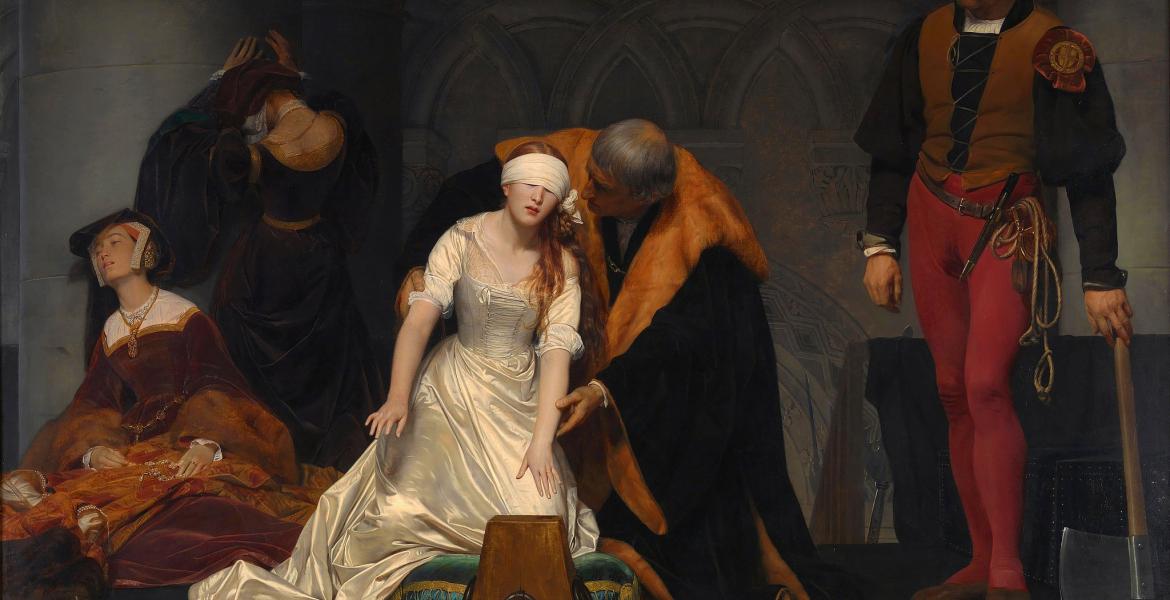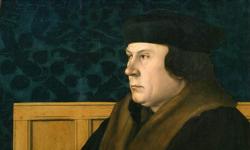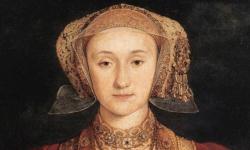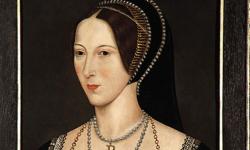The Rise and Fall of Lady Jane Grey
Key facts about Lady Jane Grey
- Lady Jane Grey was cousin to Edward VI
- She reigned for nine days, between 10 and 19 July 1553, and has become known as the Nine Days Queen
 Some question this title, as Edward VI died on 6 July 1553. However, Lady Jane Grey wasn't named as queen until 10 July 1553.
Some question this title, as Edward VI died on 6 July 1553. However, Lady Jane Grey wasn't named as queen until 10 July 1553. - Henry VIII's daughters took the crown from her, and Mary became queen
- She was executed for treason on 12 February 1554
- Many have seen her as the innocent victim of other people's - particularly her mother and father-in-law's - desire for power
- She was clever, high-spirited and a devout protestantSomeone following the western non-Catholic Christian belief systems inspired by the Protestant Reformation.
People you need to know
- Guildford Dudley - son of John Dudley and husband of Lady Jane Grey.
- John Dudley, duke of Northumberland - politician and adviser to Edward VI, then from 1550 de factoA Latin phrase meaning 'in fact', but not necessarily in law. regentSomeone who rules a state in the absence of the monarch, because the monarch is a child, absent or incapacitated.. He was the father of Guildford Dudley and Lady Jane Grey's father-in-law.
- Edward VI - a boy king and son of Henry VIII who ruled from 1547 until 1553.
- Elizabeth I - daughter of Henry VIII and his second wife, Anne Boleyn,
- Frances Grey, duchess of Suffolk - Lady Jane Grey's mother, and niece of Henry VIII. Married to Henry Grey.
- Henry Grey, duke of Suffolk - English nobleman (descended from Elizabeth Woodville, Edward IV's wife) and father of Lady Jane Grey. Married to Frances Grey.
- Lady Jane Grey - great niece of Henry VIII, and known as the 'Nine Days Queen', who ruled England in 1553.
- Henry VIII - king of England between 1509 and 1547.
- Mary I - daughter of Henry VIII and his first wife, Catherine of Aragon. She ruled from 1553 until 1558.
- Philip II of Spain - Catholic king of Spain from 1556 to 1598.
- Adrian Stokes - Master of the Horse to Frances Grey, and her second husband after Henry's death.
On 10 July 1553, four days after the death of her cousin Edward VI, Lady Jane Grey became queen of England. It would be short lived: within nine days, she would step down and be placed in the Tower of London under charges of treason. History has painted Jane as a weak female forced by an overbearing mother and father-in-law into taking the rightful place of Mary. But was this really the case: was Jane more than a pawn in the strategies of others, and was it actually Mary who was the usurper?
Edward VI was a boy king, considered weak by posterity, and under the sway of the Lord Protector John Dudley, duke of Northumberland. In January 1553 he fell ill with tuberculosis and, despite some signs of recovery, it became unlikely that he would survive. This was terrible news for England's protestants. During the reign of Edward VI's father, Henry VIII, the country had broken away from the Roman Catholic faith and established its own church, the Church of England. Under the guidance of the Protectors, Edward VI had continued the religious reforms of his father and turned England into a recognisably protestant country. The English Reformation had been significant both spiritually and socially, and the last thing protestants wanted was a Catholic monarchA king, queen, or emperor undoing all their work. But this was exactly the fate they expected, unless something was done. The boy king would never reach his majority, and certainly wouldn’t provide a protestant heir, leaving the way open for his half-sister, Mary. Mary was Henry VIII's daughter by his first marriage, and she was Catholic. Committed protestants therefore needed to find a convincing alternative to Mary, and lighted upon Lady Jane Grey.
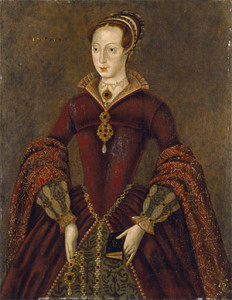
Lady Jane Grey had a good lineageA line of ancestors. with royal blood on her mother’s side (who was the niece of Henry VIII). As the eldest of the three Grey sisters, she had been named as Elizabeth's heir by Henry VIII, if none of his own children had produced one. Which, of course, none of them did. Later, Katherine Grey ranked at court as Elizabeth's unacknowledged heir, until she fell in love with and married Edward Seymour, by whom she had a son. Elizabeth, threatened by Katherine and her son's claim to the throne, had Katherine thrown in prison. Katherine starved herself to death when she was only 28 years old. The third sister, Mary, who had a less dramatic life than her two sisters, died of plague in 1578, aged 33. Perhaps more importantly she had John Dudley as her father-in-law.
Which, of course, none of them did. Later, Katherine Grey ranked at court as Elizabeth's unacknowledged heir, until she fell in love with and married Edward Seymour, by whom she had a son. Elizabeth, threatened by Katherine and her son's claim to the throne, had Katherine thrown in prison. Katherine starved herself to death when she was only 28 years old. The third sister, Mary, who had a less dramatic life than her two sisters, died of plague in 1578, aged 33. Perhaps more importantly she had John Dudley as her father-in-law. She had only recently married Dudley's son, Guildford, on 25 May 1553. She was therefore well placed to lay a claim to the throne. In June 1553, Edward wrote his Devise for the Succession which removed his half-sisters Mary and Elizabeth, whom he considered illegitimateIn terms of children, those born out of wedlock (to unmarried parents)., from the line of succession in favour of his cousin Jane. This was in direct contravention to Henry VIII’s Third Act of Succession of 1544, which named first Mary and then Elizabeth as Edward’s successors, and that had been agreed by parliament. Despite the number of signatories to Edward’s new Devise, this document remained illegal because the only way to overturn Henry’s Act was by parliament, which was due to meet on 18th September. But Edward died before this date, so Edward’s wishes legally had to be ignored.
She had only recently married Dudley's son, Guildford, on 25 May 1553. She was therefore well placed to lay a claim to the throne. In June 1553, Edward wrote his Devise for the Succession which removed his half-sisters Mary and Elizabeth, whom he considered illegitimateIn terms of children, those born out of wedlock (to unmarried parents)., from the line of succession in favour of his cousin Jane. This was in direct contravention to Henry VIII’s Third Act of Succession of 1544, which named first Mary and then Elizabeth as Edward’s successors, and that had been agreed by parliament. Despite the number of signatories to Edward’s new Devise, this document remained illegal because the only way to overturn Henry’s Act was by parliament, which was due to meet on 18th September. But Edward died before this date, so Edward’s wishes legally had to be ignored.
Edward died on 6 July 1553. Despite the legalities of the succession issue, Jane ascended the throne on 10 July 1553 and reigned for just nine days before the privy councilA monarch's private advisers. switched allegiance to Mary. Mary and Elizabeth, having evaded capture by Dudley's men, marched against her, forced her to step down, and placed her in the Tower for treason. Dudley had intended to take both princesses prisoner when they were summoned to the dying king's bedside, but someone tipped Mary off on her way to London and she fled to Norfolk, where she had herself proclaimed monarch. Elizabeth took to her bed, claiming illness as reason for not travelling to London and so she too avoided arrest. John Dudley was executed on 22 August 1553. Jane, her husband, and her father Henry were executed a year later, following the defeat of the Wyatt RebellionAn English uprising in 1554, caused by concern over Mary I's marriage to the future Philip II of Spain.. The traditional story paints Lady Jane Grey an innocent figure sacrificed on the altar of her mother and father-in-law’s ambitions; that, despite her protestations, she was engineered onto the throne as an innocent and naive 16 or 17 year old.
Dudley had intended to take both princesses prisoner when they were summoned to the dying king's bedside, but someone tipped Mary off on her way to London and she fled to Norfolk, where she had herself proclaimed monarch. Elizabeth took to her bed, claiming illness as reason for not travelling to London and so she too avoided arrest. John Dudley was executed on 22 August 1553. Jane, her husband, and her father Henry were executed a year later, following the defeat of the Wyatt RebellionAn English uprising in 1554, caused by concern over Mary I's marriage to the future Philip II of Spain.. The traditional story paints Lady Jane Grey an innocent figure sacrificed on the altar of her mother and father-in-law’s ambitions; that, despite her protestations, she was engineered onto the throne as an innocent and naive 16 or 17 year old.  No-one knows the year she was born. It is said that she fainted upon being named queen. In support of this story are the claims that her mother, Frances, was cruel, money (and power) hungry, and beat her daughter regularly; that she forced her daughter to marry Dudley’s son, Guildford; and that her heartlessness is allegedly confirmed by her remarrying within a month of her husband and child’s executions, to a 21 year-old servant named Adrian Stokes.
No-one knows the year she was born. It is said that she fainted upon being named queen. In support of this story are the claims that her mother, Frances, was cruel, money (and power) hungry, and beat her daughter regularly; that she forced her daughter to marry Dudley’s son, Guildford; and that her heartlessness is allegedly confirmed by her remarrying within a month of her husband and child’s executions, to a 21 year-old servant named Adrian Stokes.
However Frances's lack of regard for, and overbearing influence over, her daughter was not so clear cut. True, Jane complained of her harsh mother in letters, but this can hardly be seen as exceptional from a teenager. And from her tutor’s conversations, it would seem that her mother had her hands full: Jane was very ‘high-spirited’. Nor is there any evidence that Jane was forced into her marriage, although both she and her mother played the story of being innocent pawns during Jane’s trial. The fact that Jane and Frances had similar stories and explanations at the trial instead suggests that they worked together in managing her defence. Furthermore, while Frances did remarry it was over a year later to someone of her own age, the Master of the Horse and therefore hardly a mere servant.
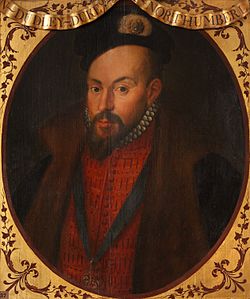
It is more difficult to find a defence for the duke of Northumberland, although not impossible. Dudley has been accused of persuading the weak Edward VI to bypass his sisters in favour of Jane to promote Dudley’s own power and ideological outlook. He has likewise been accused of intimidating over one hundred judges, peers, bishops, aldermen and members of the privy councilA monarch's private advisers.A monarch's private advisers. to sign the king’s declaration, threatening to ‘fight with any man in his shirt’ who refused, in what is known as the Dudley PutschA revolt or attempted overthrow of the government.A revolt or attempted overthrow of the government.A revolt or attempted overthrow of the government.. He was, after all, a deeply unpopular figure in Tudor England, blamed for many unpopular government decisions and for scheming to put his own son on the throne.
Many of these accusations are based on an assumption that Edward was ineffectual and had no opinions of his own, which is clearly not the case. Not the ‘articulate puppet’ Stephen Alford, Kingship and Politics in the Reign of Edward VI, (Cambridge: Cambridge University Press 2002) that some saw, he was in fact very intelligent, but his education had turned him into a hard-line protestant. It wouldn't have taken much to convince him to sideline a Catholic in favour of someone more likely to support the protestant cause. Furthermore Edward, like his father before him, was concerned to see the continuance of the Tudor line. Jane, being already married, was more likely to ensure this continuance than any children of Edward's illegitimate sisters. Edward had already shown support for the ideals of primogenitureWhere land, titles and wealth were inherited by the oldest son.Where land, titles and wealth were inherited by the oldest son.Where land, titles and wealth were inherited by the oldest son. in his first draft of the Devise, which initially passed over Jane in favour of her future sons. This was only changed when it became clear Edward had less than nine months to live. In working to fulfil the king’s wishes, it is possible to see Dudley acting correctly in his capacity as regent. The fact that he was also furthering his own interests is not relevant.
Stephen Alford, Kingship and Politics in the Reign of Edward VI, (Cambridge: Cambridge University Press 2002) that some saw, he was in fact very intelligent, but his education had turned him into a hard-line protestant. It wouldn't have taken much to convince him to sideline a Catholic in favour of someone more likely to support the protestant cause. Furthermore Edward, like his father before him, was concerned to see the continuance of the Tudor line. Jane, being already married, was more likely to ensure this continuance than any children of Edward's illegitimate sisters. Edward had already shown support for the ideals of primogenitureWhere land, titles and wealth were inherited by the oldest son.Where land, titles and wealth were inherited by the oldest son.Where land, titles and wealth were inherited by the oldest son. in his first draft of the Devise, which initially passed over Jane in favour of her future sons. This was only changed when it became clear Edward had less than nine months to live. In working to fulfil the king’s wishes, it is possible to see Dudley acting correctly in his capacity as regent. The fact that he was also furthering his own interests is not relevant.
Whatever the roles of her mother and father-in-law, there is no doubt that Jane was a willing participant. By the time Jane was 15 she was a devout protestant, who refused to accept ungodly presents from Mary. Jane rejected a gift of ‘apparel of tinsel cloth of gold and velvet, laid on with parchment lace of gold' from Mary as it was not deemed fit for a follower of God. That she therefore believed a protestantSomeone following the western non-Catholic Christian belief systems inspired by the Protestant Reformation. monarch a better choice than a Catholic monarch is hardly a surprise. She was strong-willed and clever, described as 'England's outstanding female scholar',
Jane rejected a gift of ‘apparel of tinsel cloth of gold and velvet, laid on with parchment lace of gold' from Mary as it was not deemed fit for a follower of God. That she therefore believed a protestantSomeone following the western non-Catholic Christian belief systems inspired by the Protestant Reformation. monarch a better choice than a Catholic monarch is hardly a surprise. She was strong-willed and clever, described as 'England's outstanding female scholar', Eric Ives, Lady Jane Grey: A Tudor Mystery (Chichester: Wiley-Blackwell 2009) and therefore not necessarily easily manipulated. Although monarch for just nine days, she had already established herself as queen: rather than taking Guildford as her king consort, she made him duke of Clarence, distancing him from government and stating her own authority. Moreover, she was insistent upon signing government documents in her own name. Her determination, beliefs, and character shone through even after she was imprisoned, and, it could be argued, she sealed her own fate by openly condemning the legalisation of the Catholic Mass. Through her actions she was seen as a threat and became a rallying point for treasonous activity. This is why she was executed the following year, even though she was not directly linked with the Wyatt Rebellion. She was not the weak and innocent victim history portrays her as: she was an active collaborator.
Eric Ives, Lady Jane Grey: A Tudor Mystery (Chichester: Wiley-Blackwell 2009) and therefore not necessarily easily manipulated. Although monarch for just nine days, she had already established herself as queen: rather than taking Guildford as her king consort, she made him duke of Clarence, distancing him from government and stating her own authority. Moreover, she was insistent upon signing government documents in her own name. Her determination, beliefs, and character shone through even after she was imprisoned, and, it could be argued, she sealed her own fate by openly condemning the legalisation of the Catholic Mass. Through her actions she was seen as a threat and became a rallying point for treasonous activity. This is why she was executed the following year, even though she was not directly linked with the Wyatt Rebellion. She was not the weak and innocent victim history portrays her as: she was an active collaborator.
Things to think about
- Did Lady Jane Grey have a legitimate claim to the throne?
- Was Jane the innocent victim of other people's scheming?
- What was Jane's relationship with her family like?
- Was Edward VI capable of making his own decisions, and what was his own opinion on the succession?
- How much power and influence did Dudley have in getting Lady Jane Grey onto the throne?
Things to do
- As with much of English history, the Tower of London played an important part in Lady Jane Grey's life. She lived there both when she was queen and when she was being held by Mary, and was executed on Tower Green. Jane and her husband are buried in the Chapel of St Peter ad Vincula on Tower Green. Our review on visiting the Tower of London can be found here and you can find out more information and buy tickets here.
- Kenilworth Castle was given to John Dudley in 1553. It is now an atmospheric ruin in the hands of English Heritage. You can read our review of it here and find out more about visiting by clicking here.
- Dudley Castle was once owned by John Dudley, and Lady Jane Grey's ghost is said to haunt it (the attraction also runs organised ghost hunts and talks). It now stands in the grounds of Dudley Zoo, and you have to buy a zoo ticket to gain access to the castle. You can find out more information here.
Further reading
As Lady Jane Grey is such an interesting subject, there are a number of biographies on the market. Two of the best are Eric Ives' Lady Jane Grey: A Tudor Mystery and Leanda de Lisle's The Sisters Who Would Be Queen: The Tragedy of Mary, Katherine and Lady Jane Grey.
- Log in to post comments


